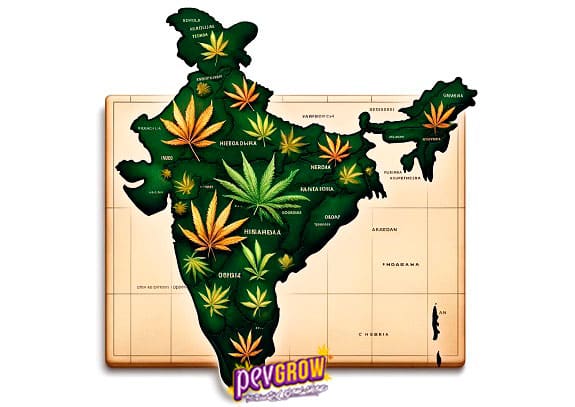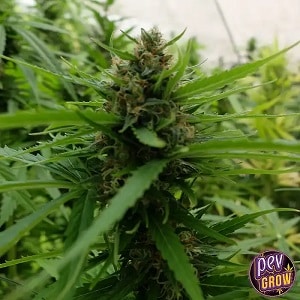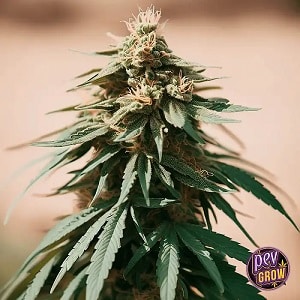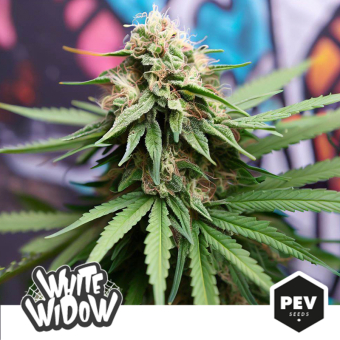- Discover the landrace cannabis strains from India: energizing sativas, relaxing indicas, and unique hybrids, each adapted to the different climates and regions of India.
- Landraces: The pure marijuana strains
- The best sativa marijuana seeds in the world


In constant struggle for the regulation of cannabis, mainly in the medicinal field.
01-05-2024 07:00:00 - Updated: 1 May, 2024
India is a treasure trove of biodiversity, and this is reflected in the rich strain of landrace cannabis found throughout the subcontinent. From the heights of the Himalayas to the tropical plains of the south, each region has cultivated strains that not only survive but thrive in their local environments. This article explores these unique Indian landrace strains, highlighting their distinctive characteristics and the effects they offer.
⭐ List of Indian Landraces
India, with its rich biodiversity and a wide range of climates, is the origin of numerous landrace cannabis strains, each adapted to its particular environment and with unique characteristics. Here is a comprehensive list of the most representative landrace strains of the Indian subcontinent.
Malana Cream:
Originating from the Malana Valley in Himachal Pradesh, this strain is known for its exceptional resin used to produce high-quality charas, considered by many to be the best hashish in the world. The geographical and cultural isolation of Malana has contributed to the creation of a strain with unique characteristics and special aromas, famous for its creamy texture and euphoric effects with a relaxing comedown.
Idukki Gold:
Coming from the Western Ghats in Kerala, Idukki Gold is one of the most potent strains in India, increasingly rare, known for its strong cerebral effects and alertness, often described by its powerful and lasting impact.
Rasol:
This strain is grown in the remote village of Rasol, at nearly 3000 meters above sea level. It is known for its ‘Rasol Cream’, one of the best hashish creams in India. Local growers maintain a relatively pure genetics, allowing the plant to express a wide range of flavors and effects, typically fruity and spicy.
Kashmiri:
Grown in the highlands of Jammu and Kashmir, this strain often shows indica characteristics in its structure. It is known for its sweet and fruity aroma, being used for both recreational and medicinal purposes.
Manipuri:
The Manipuri strain, originating from the Imphal Valley in Manipur, is a landrace Sativa known for its adaptability to different climates and ease of cultivation both indoors and outdoors. This strain is highly valued by local growers, who select seeds from the strongest plants for future harvests. Manipuri buds are known for their floral and citrus aromas with a hint of mint, offering an intense and energizing effect, although it is also noted for being more calming compared to other Southeast Asian sativas.
Parvati:
The Parvati strain, named after the Parvati Valley in Himachal Pradesh, is famous for its sticky resin and relaxing effects. This high-mountain sativa is preferred for its short flowering period and for producing a cerebral effect that is both uplifting and psychedelic. Farmers in the Parvati Valley are experts in selecting specific phenotypes, which ensures consistency in the flavor and quality of the charas (hashish) produced.
Kerala:
The Kerala strain, known for its resilience and robustness, stands out in the tropical and humid environment of southern India. This strain is famous for its potency and resistance to local diseases, making it highly appreciated for both recreational and medicinal use. The Kerala offers typical invigorating sativa effects, with an euphoric onset that remains energetic and alert. It is considered one of the best sativas on the planet, so much so that it is one of the parents of hybrids as famous as the Haze or the White Widow.
Orissa Gold:
Orissa Gold is a prized strain from Orissa, known for its high quality and adaptability to the humid and tropical climate of the region. This sativa has a flowering period of between 18 and 20 weeks, and is appreciated for its floral aroma combined with incense, producing an active and euphoric effect that is highly valued by consumers.
Nanda Devi:
Named after the Nanda Devi mountain, this strain grows at high altitudes and has a surprisingly fast flowering cycle of 10 to 11 weeks for a sativa. The buds of Nanda Devi are dense and resinous, with an aroma that combines floral, spicy, and herbal notes, and produce an intense and uplifting effect that then balances into a lasting and positive buzz.
Hindu Kush:
Although more commonly associated with the region between Afghanistan and Pakistan, the Hindu Kush is also grown in northern India, where it has adapted to local conditions. This pure indica is famous for its narcotic and uplifting effects, with an aroma that combines spices, rotten fruits, pine, and coffee.

⛳ Table of Indian Landraces
| Variety | Type | Location | Outstanding Features |
|---|---|---|---|
| Malana Cream | Indica/Hybrid | Himachal Pradesh, Malana | High-quality resin, euphoric and relaxing effects, ideal for charas. |
| Idukki Gold | Sativa | Kerala | High THC content, powerful and energizing effects. |
| Manipuri | Sativa | Manipur | Dense buds, earthy aroma, easy to grow, energetic effects. |
| Parvati | Indica/Hybrid | Himachal Pradesh, Parvati Valley | Sticky resin, relaxing effects, short flowering period. |
| Kerala | Sativa | Kerala | Robustness and resistance to diseases, adapted to humid and tropical climate. |
| Orissa Gold | Sativa | Orissa | Superior quality, resistant to humid climate, active and euphoric effects. |
| Nanda Devi | Sativa | Uttarakhand, Nanda Devi | Adapted to high altitudes, dense and resinous buds, intense effects. |
| Hindu Kush | Indica | Northern India | Narcotic and uplifting effects, aroma of spices and rotten fruits. |
| Rasol | Sativa | Himachal Pradesh, Rasol | Exceptional hash quality, adaptation to high altitudes, fruity and spicy flavors. |
| Kashmiri | Indica | Jammu and Kashmir, Kashmir | Relaxing and sedative effects, ideal for medicinal use. |
✨ Indian Landrace Varieties: Sativa or Indica?
The geographical and climatic diversity of India has resulted in an impressive strain of cannabis subspecies, including sativas, indicas, and ruderalis. This wide spectrum of strains is a direct result of the multiple latitudes, microclimates, and geographical features of the country.
Sativa Varieties
Most of the landrace strains from India are classified as sativas, commonly known as “Cannabis sativa” or NLD (narrow-leaf drug). These strains are characterized by having thinner and longer leaves, and they usually grow in low-latitude areas where the days are longer. Indian sativas are known for their energizing and psychoactive effects, typically offering a more cerebral or “head high” experience. Due to their adaptation to warm and humid climates, these plants can reach impressive heights and have a longer flowering period.
Indica Varieties
Contrary to popular belief, true indica strains (BLD – broad-leaf drug) are not native to India, but rather to regions closer to the Hindu Kush, which include parts of Afghanistan, Pakistan, and the border with China. However, in India, strains that show typical indica physical characteristics, such as wider leaves, relaxing effect, and a more compact structure, can be found. These are usually found in mountainous and high regions where the climate is colder, which favors a shorter flowering cycle.
Ruderalis Varieties
Although less common, some strains of Cannabis ruderalis, known for their ability to flower independently of light hours (autoflowering), have also been identified in the colder and northern regions of India. These plants are generally smaller and are rarely used for recreational or medicinal purposes due to their low THC content.
🚀 Adaptive Diversity
The vast range of cannabis strains in India is a testament to the plant’s adaptability. Each strain has evolved to optimize its survival and reproduction in its particular ecological niche, resulting in a genetic diversity that is both a scientific and cultural resource. Cannabis growers and conservationists value these landrace strains for their unique genetic potential, which can be crucial for the development of new hybrid strains adapted to specific agricultural challenges or to produce desired cannabinoid and terpene profiles.
🔥 Effects of Indian Landrace Varieties
The landrace cannabis strains in India offer a diverse range of effects, depending on their subspecies: sativa, indica, spontaneous hybrids, and ruderalis. Each type has unique characteristics that influence their psychoactive and therapeutic effects.
Effects of Indian Sativas
Indian sativa strains are known for their stimulating and cerebral effect. In India, these strains typically produce an “energetic high” and often psychedelic, ideal for daytime use. Users report an increase in creativity, energy, and a feeling of euphoric well-being. Due to their prolonged flowering period and adaptation to warm and humid climates, Indian sativas like Malana Cream and Idukki Gold are appreciated for their exceptional quality and potency.
Effects of Indian Indicas
Although true indicas are not native to India, strains that show indica characteristics in mountainous regions tend to offer more relaxing and sedative effects. These effects are suitable for pain relief, insomnia, and stress. The compact structure of these plants and their shorter flowering cycle adapt well to colder and higher climates, producing dense and resinous buds with deep flavors and aromas.
Spontaneous Hybrids
In such a diverse environment as India, cross-pollination between different landrace strains has resulted in spontaneous hybrids. These hybrids combine characteristics of sativas and indicas, offering a strain of effects that can include the cerebral euphoria of sativas along with the body relaxation of indicas. These hybrids are especially valued for their versatility and ability to offer a balance between stimulation and calm, depending on the proportions of their genetic heritage.
Ruderalis Varieties
Ruderalis in India are less common and generally not cultivated for recreational use due to their low THC content. However, these autoflowering plants can be important for research and development of new cannabis seeds, especially for creating strains that bloom independently of the light cycle.

🎯 Conclusion
The landrace strains from India not only offer a window into the history and culture of cannabis in the region, but they also possess invaluable value for breeders and cannabis enthusiasts around the world. If you liked what you read here, you can’t miss this other article that talks about the best Kush marijuana strains, as some of them are directly related to the landraces in this entry.








Amazing article about Indian landrace varieties! I had no idea about the rich biodiversity and cultural significance of these plants in local agriculture.